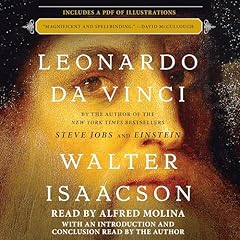
Caravaggio
A Life Sacred and Profane
No se pudo agregar al carrito
Add to Cart failed.
Error al Agregar a Lista de Deseos.
Error al eliminar de la lista de deseos.
Error al añadir a tu biblioteca
Error al seguir el podcast
Error al dejar de seguir el podcast
Obtén 3 meses por $0.99 al mes + $20 de crédito Audible
 Exclusivo para miembros Prime: ¿Nuevo en Audible? Obtén 2 audiolibros gratis con tu prueba.
Exclusivo para miembros Prime: ¿Nuevo en Audible? Obtén 2 audiolibros gratis con tu prueba.
Compra ahora por $29.95
-
Narrado por:
-
Edoardo Ballerini
In the tradition of John Richardson's Picasso, a commanding new biography of the Italian master's tumultuous life and mysterious death. For four hundred years Caravaggio's (1571-1610) staggering artistic achievements have thrilled viewers, yet his volatile personal trajectory - the murder of Ranuccio Tomasini, the doubt surrounding Caravaggio's sexuality, the chain of events that began with his imprisonment on Malta and ended with his premature death - has long confounded historians. In a bravura performance, Andrew Graham-Dixon delves into the original Italian sources, presenting fresh details about Caravaggio's sex life, his many crimes and public brawls, and the most convincing account yet published of the painter's tragic death at the age of thirty-eight. With illuminating readings of Caravaggio's infamous religious paintings, which often depict prostitutes and poor people, Graham-Dixon immerses readers in the world of Italy at the height of the Counter-Reformation and creates a masterful profile of the mercurial painter's life and work.
©2010 Andrew Graham-Dixon (P)2013 Audible, Inc.Los oyentes también disfrutaron:




















Las personas que vieron esto también vieron:


















Michael Angelo Marsi Caravaggio
Se ha producido un error. Vuelve a intentarlo dentro de unos minutos.
Author and Narrator Bring Caravaggio to Life
Se ha producido un error. Vuelve a intentarlo dentro de unos minutos.
The narrator is exceptional in both tone and feeling. If you love classical art, tragedy and The Bible. This is a book worth your time.
Truly Sacred, truly beautiful, sadly profane...
Se ha producido un error. Vuelve a intentarlo dentro de unos minutos.
Loved it.
Se ha producido un error. Vuelve a intentarlo dentro de unos minutos.
Deep dive into a life shrouded in mystery
Se ha producido un error. Vuelve a intentarlo dentro de unos minutos.
Read this even if you are not familiar with Caravaggio, art history or painting generally. There is so much here.
Se ha producido un error. Vuelve a intentarlo dentro de unos minutos.
Caravaggio
Se ha producido un error. Vuelve a intentarlo dentro de unos minutos.
Wow
Se ha producido un error. Vuelve a intentarlo dentro de unos minutos.
Interesting life
Se ha producido un error. Vuelve a intentarlo dentro de unos minutos.
The author carefully introduced Caravaggio's world and why his paintings were so radical at the time both as art and religious symbolism. Occasionally, I would have to look up a word like "Mannerism" or "Baroque" means as I know less than even Art 101. Some reviewers have criticized that Andrew Graham-Dixon was too thorough with the story's context. I disagree as the political and religious subtext of Caravaggio's youth permeate his works and help clarify why he makes certain decisions later in life.
The narration is simply perfect. I would rank Ballerini as high as the legendary Frank Muller. A few tips: Wikipedia's list of all Caravaggio's work is a must so you can see the artworks (and see where it's located presently). Don't be afraid to rewind. There are a lot of names and works mentioned which can sometimes be missed if (like me) you're driving as you listen. I rewound quite a few times to ensure I knew exactly what was being said as oftentimes the author will analyze two works in the same chapter. If you plan on reading this and a book about Michelangelo (like Michelangelo and The Pope's Ceiling, which I loved), then I'd recommend reading Michelangelo first. Michelangelo's influence pops up a few times in this work and that extra bit of context is nice to have (but not necessary).
Ultimately, this is one of my favorite audiobooks ever and I'm so glad I read this before visiting Italy so I can truly appreciate his work. I highly recommend it even if you're a total art novice like myself.
Bellisimo!
Se ha producido un error. Vuelve a intentarlo dentro de unos minutos.


